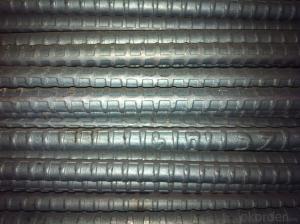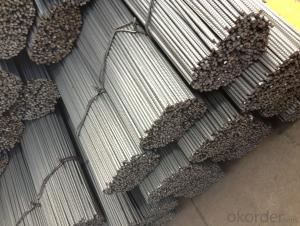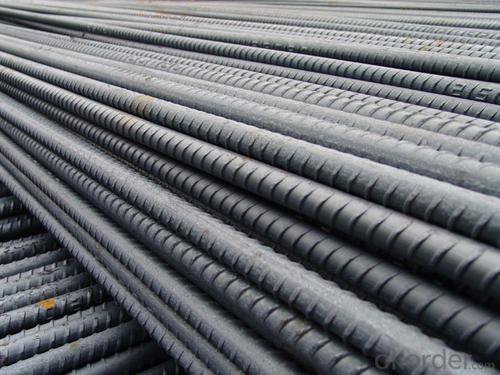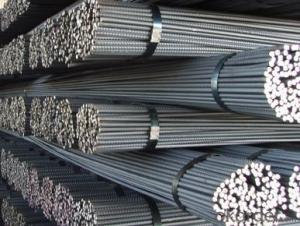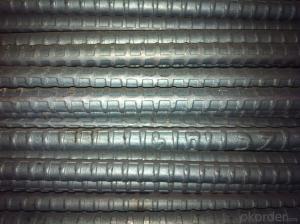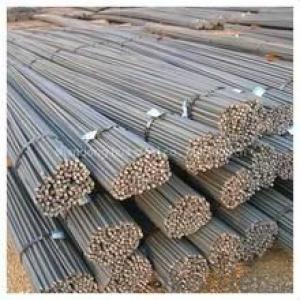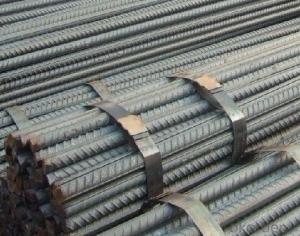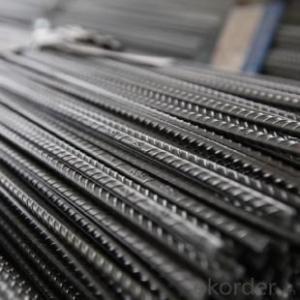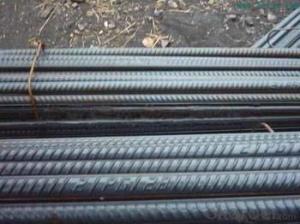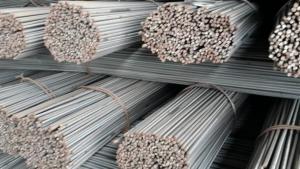Deformed Steel Bar, 10mm 12mm Steel Rebar
- Loading Port:
- China main port
- Payment Terms:
- TT or LC
- Min Order Qty:
- 100 m.t.
- Supply Capability:
- 100000 m.t./month
OKorder Service Pledge
OKorder Financial Service
You Might Also Like
Product Description:
OKorder is offering Deformed Steel Bar, 10mm 12mm Steel Rebar at great prices with worldwide shipping. Our supplier is a world-class manufacturer of steel, with our products utilized the world over. OKorder annually supplies products to African, South American and Asian markets. We provide quotations within 24 hours of receiving an inquiry and guarantee competitive prices.
Product Applications:
Deformed Steel Bar, 10mm 12mm Steel Rebar are ideal for structural applications and are widely used in the construction of buildings and bridges, and the manufacturing, petrochemical, and transportation industries.
Product Advantages:
OKorder's Deformed Steel Bar, 10mm 12mm Steel Rebar are durable, strong, and wide variety of sizes.
Main Product Features:
· Premium quality
· Prompt delivery & seaworthy packing (30 days after receiving deposit)
· Can be recycled and reused
· Mill test certification
· Professional Service
· Competitive pricing
Product Specifications:
Manufacture: Hot rolled
Grade: HRB335,HRB400,HRB500
Certificates: ISO, SGS, BV, CIQ
Length: 6m – 12m, as per customer request
Packaging: Export packing, nude packing, bundled
Deformed Steel Bar | ||
Diameter (MM) | Cross Sectional Area (MM2) | Theorectical Weight (KG/M) |
6 | 28.27 | 0.222 |
8 | 50.27 | 0.395 |
10 | 78.54 | 0.617 |
12 | 113.1 | 0.888 |
14 | 153.9 | 1.21 |
16 | 201.1 | 1.58 |
18 | 254.5 | 2 |
20 | 314.2 | 2.47 |
22 | 380.1 | 2.98 |
25 | 490.9 | 3.85 |
28 | 615.8 | 4.83 |
32 | 804.2 | 6.31 |
36 | 1018 | 7.99 |
40 | 1257 | 9.87 |
Grade | Technical data of the original chemical composition (%) | |||||||
C | Mn | Si | S | P | V | |||
HRB500 | ≤0.25 | ≤1.60 | ≤0.80 | ≤0.045 | ≤0.045 | 0.04-0.12 | ||
Physics capability | ||||||||
Yield Strength(N/cm2) | Tensile Strength(N/cm2) | Elongation (%)
| ||||||
≥500 | ≥630 | ≥12 | ||||||
FAQ:
Q1: Why buy Materials & Equipment from OKorder.com?
A1: All products offered byOKorder.com are carefully selected from China's most reliable manufacturing enterprises. Through its ISO certifications, OKorder.com adheres to the highest standards and a commitment to supply chain safety and customer satisfaction.
Q2: How many tons of steel products could be loaded in containers?
A2: Usually the steel products are delivered by bulk vessel because of the large quantity and the freight. However, there are no bulk vessel enter some seaports so that we have to deliver the cargo by containers. The 6m steel product can be loaded in 20FT container, but the quantity is changed according to the size, usually from 18tons to 25tons.
Q3: How soon can we receive the product after purchase?
A3: Within three days of placing an order, we will arrange production. The normal sizes with the normal grade can be produced within one month. The specific shipping date is dependent upon international and government factors, the delivery to international main port about 45-60days.
Images:
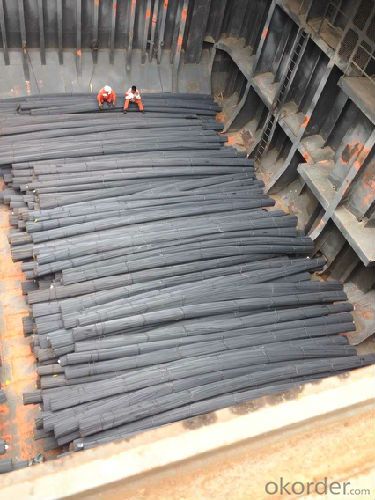
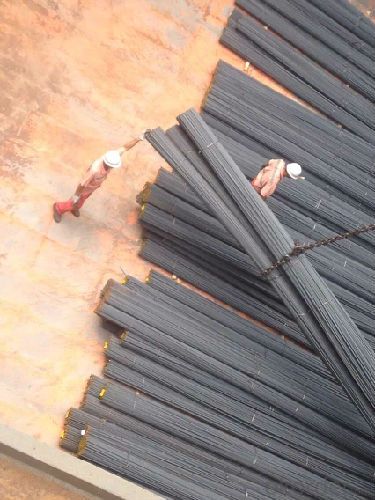
- Q: What is the process of inspecting steel rebars before installation?
- The process of inspecting steel rebars before installation typically involves visual examination, measurement, and testing. The rebars are visually inspected for any visible defects such as cracks, rust, or bending. Measurements are taken to ensure the rebars meet the required dimensions, length, and diameter specified in the design. Additionally, non-destructive testing methods like ultrasonic testing or magnetic particle inspection may be performed to detect any hidden defects or irregularities. This thorough inspection process helps ensure the quality and integrity of the rebars before they are installed in construction projects.
- Q: Can steel rebars be used in historical building preservation?
- Yes, steel rebars can be used in historical building preservation. They are commonly used to strengthen and reinforce existing structures, ensuring their structural integrity. Steel rebars provide additional support and stability to historical buildings without compromising their original architectural integrity.
- Q: Can steel rebars be used in seismic zones?
- Yes, steel rebars can be used in seismic zones. In fact, they are commonly used in construction projects located in areas prone to earthquakes. The high tensile strength and ductility of steel rebars make them an excellent choice for reinforcing concrete structures, ensuring their stability and resistance against seismic forces. Additionally, steel rebars can be designed and installed in a way that enhances the overall seismic performance of buildings and infrastructure.
- Q: Can steel rebars be used in structures with high resistance to abrasion?
- Structures that require high resistance to abrasion can benefit from the use of steel rebars. Reinforced concrete structures often incorporate steel rebars to enhance their strength and durability. The specific steel chosen for rebars is known for its exceptional tensile strength and ability to withstand various environmental conditions. While the rebars themselves may not possess inherent resistance to abrasion, the concrete surrounding them offers protection against this. When properly designed and constructed, reinforced concrete structures with steel rebars can endure significant levels of abrasion without compromising their structural integrity. For areas with particularly harsh abrasion or corrosive environments, epoxy-coated rebars can be employed to provide an additional layer of protection against both abrasion and corrosion.
- Q: What is the impact strength of steel rebars?
- The impact strength of steel rebars is high, making them capable of withstanding heavy loads and absorbing energy without breaking or fracturing easily.
- Q: How do steel rebars resist abrasion in concrete structures?
- Steel rebars resist abrasion in concrete structures due to their high tensile strength and durable nature. The rough surface of the rebars provides better adhesion with the concrete, preventing slippage and ensuring a strong bond between the two materials. Additionally, the steel rebars act as reinforcement, distributing the load evenly and reducing the chances of cracks or spalling caused by abrasion or heavy impacts. Overall, the presence of steel rebars greatly enhances the durability and longevity of concrete structures.
- Q: Can steel rebars be used in seawater desalination plants?
- Yes, steel rebars can be used in seawater desalination plants, but it is important to consider the corrosion potential of steel in a saline environment. Proper corrosion protection measures, such as using corrosion-resistant coatings or stainless steel rebars, should be implemented to ensure the longevity and structural integrity of the plant.
- Q: How do steel rebars help in preventing cracks in concrete structures?
- Steel rebars contribute to the prevention of cracks in concrete structures by providing reinforcement and enhancing the tensile strength of the concrete. While concrete possesses strength in compression, it lacks strength in tension, making it prone to cracking when exposed to external forces or temperature changes. However, by embedding steel rebars within the concrete, the rebars absorb the tensile forces, thereby preventing the concrete from cracking. The rebars function as a framework within the concrete, evenly distributing the tension forces and averting the formation of significant cracks. This reinforcement also regulates the size and width of any cracks that do appear, minimizing their impact on the overall structural integrity. Moreover, steel rebars assist in crack prevention by enhancing the ductility of concrete. Ductility refers to a material's ability to deform without breaking. The steel rebars offer flexibility to the concrete, allowing it to undergo minor deformations without cracking. Furthermore, steel rebars aid in crack prevention by mitigating the effects of shrinkage and expansion. As concrete dries, it tends to shrink, while exposure to high temperatures causes it to expand. These forces of shrinkage and expansion can lead to cracking. However, the presence of steel rebars counteracts these effects by absorbing and dispersing the forces. In conclusion, steel rebars play a vital role in averting cracks in concrete structures by reinforcing the concrete, augmenting its tensile strength, improving its ductility, and counterbalancing the effects of shrinkage and expansion. This reinforcement ensures the concrete's structural integrity and durability, rendering it more resistant to cracking and enhancing its overall performance and lifespan.
- Q: Can steel rebars be bent without compromising their strength?
- Steel rebars possess the ability to be bent while still maintaining their strength. Their high tensile strength enables them to endure the forces of bending and stretching without experiencing any breakage or loss of structural integrity. The process of bending involves the application of a regulated amount of force to the rebar, causing the material to deform and acquire a new shape. However, it is essential to adhere to the recommended limits and guidelines provided by the manufacturer or industry standards when carrying out the bending procedure. Exceeding the specified limits may result in the development of microcracks or other defects that can compromise the strength of the rebar. Therefore, it is of utmost importance to employ proper bending techniques and utilize suitable equipment to ensure that the steel rebars retain their strength even after being bent.
- Q: What are the different methods of protecting steel rebars against corrosion?
- There are several methods used to protect steel rebars against corrosion. These methods include applying a protective coating such as epoxy or zinc, using galvanized rebars, implementing cathodic protection systems, and incorporating corrosion inhibitors in the concrete mix. These techniques help to prevent the penetration of moisture and corrosive substances, prolonging the lifespan and structural integrity of the rebars.
Send your message to us
Deformed Steel Bar, 10mm 12mm Steel Rebar
- Loading Port:
- China main port
- Payment Terms:
- TT or LC
- Min Order Qty:
- 100 m.t.
- Supply Capability:
- 100000 m.t./month
OKorder Service Pledge
OKorder Financial Service
Similar products
Hot products
Hot Searches
Related keywords

